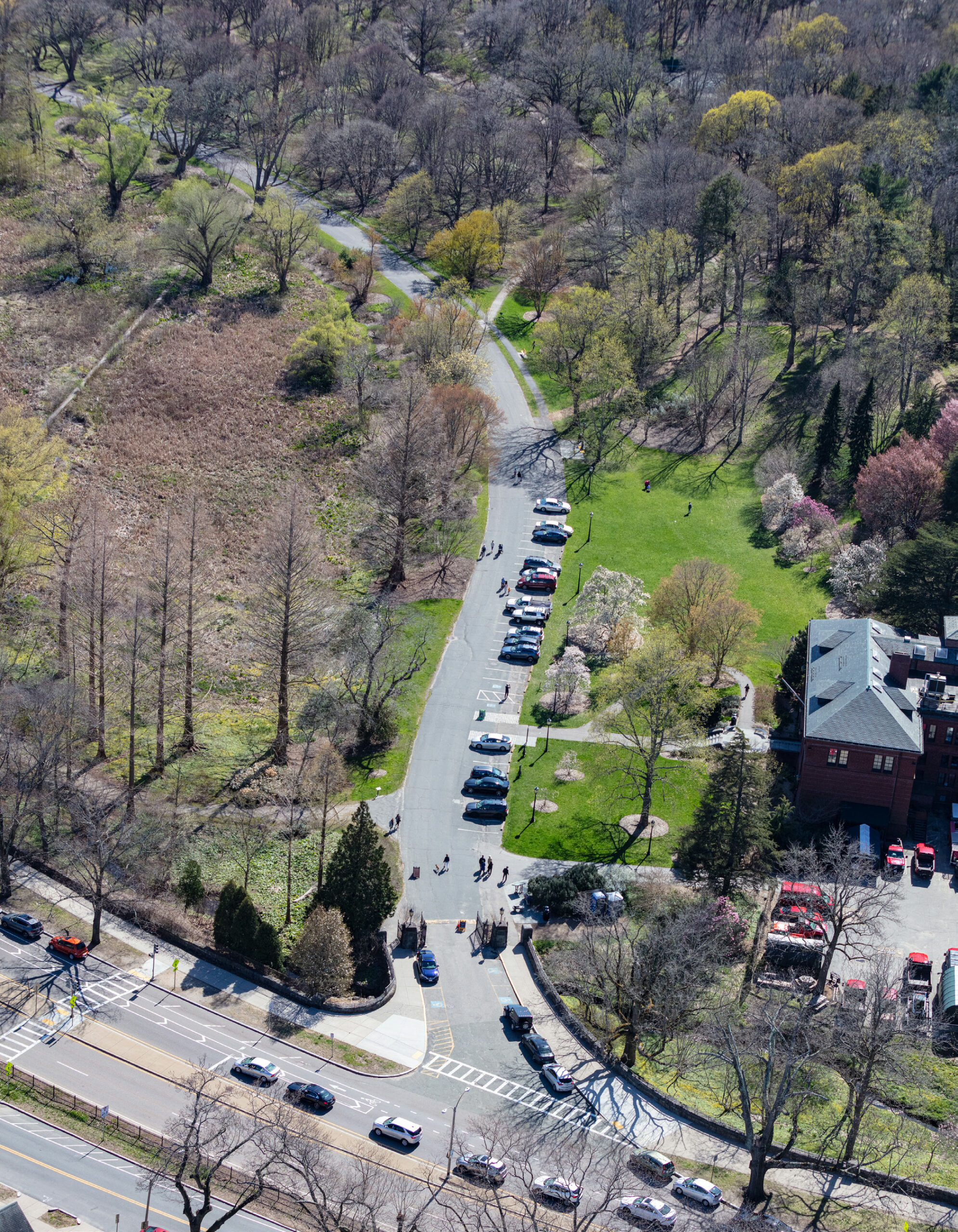Forum at Weld Hill explores the history, philosophy, and future of the Arboretum’s entrances
A gate is much more than a piece of infrastructure. It’s also an archetype, and an ambivalent one—a portal that’s also a barrier, an impediment masquerading as an entrance. The Arnold Arboretum features nineteen entrances situated around its three-mile perimeter—entryways to the landscape that come in a variety of shapes and sizes, from backyard stiles in Roslindale to the broad, swinging, wrought-iron gates that open on the Arborway and South Street.
The Arboretum’s Entrance Improvement Project seeks to renew and improve the Arboretum’s many entrances to provide a safe, accessible, and welcoming experience for all visitors. Stewarded by the storied landscape design firm, Michael Van Valkenburgh Associates (MVVA), the project launched with an analysis of five key entrances: Washington Street Gate (opposite the Forest Hills MBTA station), Poplar Gate, Walter Street Gate, Arborway Gate, and Beech Path Gate. Selected chiefly for their accessibility to the widest possible cross-section of the Arboretum’s diverse neighboring populace, these entrances will see the first phase of construction, likely kicking off in 2024.
In a recent conversation with staff and the design team for the Entrance Improvement Project, Arboretum supporters had the chance to explore these ambitions. The plan needs to be ambitious and far-reaching—as William (Ned) Friedman, director of the Arnold Arboretum and Arnold professor of organismic and evolutionary biology at Harvard, pointed out, “the twentieth century was pretty tough on every public green space.” Archival sketches and photographs remind us of the elegance intended for these entrances, portals conceived in the late nineteenth century to ennoble the Arboretum and its visitors. Yet much has changed in the century and a half since these gates first swung on their hinges. By a process of a thousand cuts, hasty fixes, and sacrifices made to the expediencies of maintenance, the Arboretum’s broad carriageways gave way to broken sidewalks, and stately entranceways were buried under asphalt.

The improvements to come will prioritize environmental justice, connect with underserved populations, and privilege the pedestrian over the automobile, communicating a sense of welcome and converting gates back into entrances. At the same time, Friedman suggested, it’s crucial that we “design with a timeframe of trees,” seeking durable structures and amenities for visitors arriving to the Arboretum and honoring the values and design language of its renowned architect, Frederick Law Olmsted.
Although Olmsted’s approach was subtle in many ways, it was deeply felt, both in its attention to the natural world and its ethic of access to all. “A bend in the road is such a simple thing,” noted Matthew Girard, an associate principal in the landscape design firm of Michael Van Valkenburgh who leads the project’s design team. Simple, yet profound, a sinuous curve offers “a constantly unfolding view of the trees you’re here to visit.” The designers’ approach strives to “ungate” the Arboretum, transforming each entrance from a hardened barrier of stone and iron into a “threshold of a much larger terrain of welcome.” In their vision, planting areas spill out of the landscape into the street and offer seating for respite as visitors transition from the bustle of the city to the contemplative surround of the Arboretum.

Building on the need for experiences of unity and belonging, Michael Van Valkenburgh talked about the importance of “thickening the threshold” of the Arboretum, beckoning visitors and bringing them together. Referencing the architectural renderings made by MVVA associates Soo Ran Shin and Dominic Malacaman, Van Valkenburgh described how one drawing depicts two young men on bicycles at the Arborway gate, who twist towards the entrance with curiosity, leaning over their handlebars as they’re drawn into the landscape. ”This is about the people who haven’t been here before,” the architect said. “This is about those teenage kids riding down the sidewalk and saying, ‘I’m going [into the Arboretum], and it feels like it wants me to be here.'”
As Friedman put it, “we want this to be a design language that rolls out across the country… that asks every city to look at their public green spaces and think about them in a different way: how do we welcome people [and] how do we foreground plants?”

Historian Ethan Carr, an authority on Frederick Law Olmsted and advisor for the project, described the emergence of a “renaissance” in Boston’s parks. From the installation of the “The Embrace” on Boston Common, to the action plan for Franklin Park, to the Urban Forest Plan unveiled by Mayor Wu at the Arboretum last September, vast changes are afoot, all centering equity as cultural force, environmental policy, public-health measure, and public good. It’s a vital time to rethink the portals to our parks, to reimagine the gates as entrances in the fullest possible sense.
In 2005, the artists Christo and Jeanne Claude debuted their massive project, The Gates in New York City’s Central Park. Like all the artists’ massive public projects, The Gates was a work of elite art radically open to all. It also was enormously complex bureaucratically and logistically—and yet, as Christo liked to say, this complexity was the point: “The art project is right now, here,” he says, speaking at a planning meeting in the 2007 documentary that tells the story of the work. “Everybody here is part of the work.” Inviting everyone to be part of this landscape of trees in time—this is the essence of entrance, and the essence of the Arnold Arboretum as well.
Learn more about the Entrance Improvement Project on our website.

